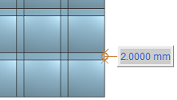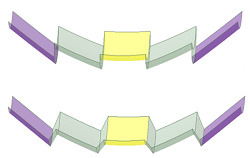Manufacturing
The Manufacturing or Drafting option allows you to consider and anticipate mechanical constraints coming from the lenses' manufacture.
Note: This option is not available for the Stripes grid type and is compatible with a circular grid only if the Shift type is Radial.
Lenses generated without drafting induce a manufacturing issue when they are removed from their mold.
Activating the Drafting allows you to take into account mechanical constraints and ensure an accurate manufacture.
Note: Drafting reduces the facets' size. This operation is automatically taken into account by the algorithm generating the elements. As a consequence, the photometry is kept during the drafting operation no matter how high the drafting value is.
Drafting can be done by length or by angle:
- When selecting Draft length, the value to define determines the size of the sewing surface created between two adjacent elements.


Rectangular Optical lens with a drafting of 2mm Circular Optical lens with a drafting of 2mm - When selecting Draft angle, the value to define determines the angle to create between the demolding axis and the facet.
Note: Draft Angle is not supported if you try to apply a draft angle on 3 groups of one or more facets that share a same vertex.



Draft angle Demolding axis Impact of drafting angle on an optical surface
Note:
The Draft angleDraft Angle is not supported when pillows/faces have edges in common connected to vertices that are at different levels, as seen in the following example:
_OPD_Draft_Angle_Case_Not_Supported.png)
_OPD_Draft_Angle_Case_Not_Supported.png)
In this case, we recommend you to use the Draft length.


